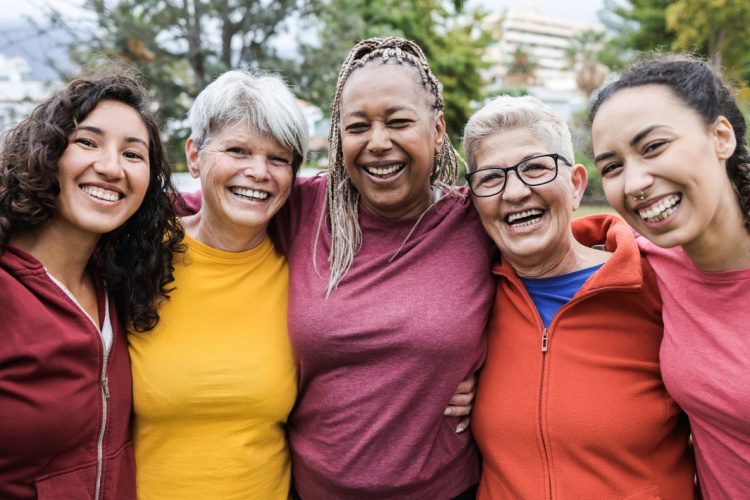by Caitlin H,
February 19, 2024

You know exercise is essential, with countless studies showing it improves everything from heart health to immunity, skin vitality, and more. But if you’re getting better at life, you’re likely to find that any exercise becomes more difficult as you age—whether or not you were once an avid exerciser.
For example, running a mile or two in your early 20s may seem challenging, but it’s not too difficult. When you’re in your 40s or older, it’s a completely different story – running a mile can take a lot of training.
The reality is that while you should always strive to make exercise an integral part of your life, it will look different at different stages of your life – and that’s okay.
We’ve put together a plan that tailors fitness to your age, plus some expert-recommended exercise methods, to make incorporating exercise into your daily life as easy as possible.
20s
Ah, your early twenties – you’re in your prime, you’re full of energy, you have the ability to stay up late and go to work the next day with no problem – it’s a glorious time indeed in terms of physical health.
Being younger means you can exercise longer and harder. With this in mind, aim for at least 60 minutes of cardio three times a week and two to three weight lifting sessions a week. Be sure to challenge your body by increasing speed and resistance each time.
- Running, cycling, crossfit, yoga
- weight training
30 seconds
The later you enter your 30s, the more likely you are that you won’t be able to stay up late or engage in high-intensity exercise without recovery time.
That’s why you might want to replace some of your core cardio with resistance training, which can help fight conditions like osteoporosis and arthritis. If you struggle with steady-state cardio (i.e. running) most of the time, it might be time to try high-intensity interval training or a low-impact option a few times a week. This may also be a good time to hire a personal trainer to help you develop habits that work for your personal life.
- Circuit training, spinning
- Push, pull, squat
More than 40 years old
If you haven’t noticed changes in your body yet, you may start to notice them in your 40s. Your metabolism will naturally slow down and your muscle mass will begin to decrease, especially if you haven’t been lifting heavy weights before. You should plan on doing low-intensity aerobic exercise for around 45 minutes at least five days a week, and focus more on resistance training and increasing the intensity of lifting weights. You’ll also want to pay close attention to each part of your body and adjust your daily activities according to the areas that need more movement.
- Climbing stairs, hiking, jogging
- Squats, Pilates, weightlifting
Over 50 years old
If you’re in your 50s and haven’t done so yet, now is an even more important time to target your bones and muscles, especially your core, back and shoulders. Strength training can increase bone density and help slow muscle loss with aging. You may also want to shorten your cardio sessions (perhaps more frequently) to give your body ample recovery time between each workout. Warming up, cooling down and stretching are also more important now.
- Low-impact exercise, walking, stationary bike
- Curls and presses, planks, lunges
the 60’s
Those years spent leaning over a keyboard or staring at a computer screen may start to show in your 60s. Back pain and poor posture (e.g., the classic “hunch”) can be a problem. Thankfully, you can combat both conditions with back and shoulder exercises and short bursts of aerobic exercise throughout the week. You may need to cut back on aerobic exercise that puts a lot of stress on your joints, such as running, but you can replace it with slower aerobic exercise that doesn’t put as much stress on your joints and muscles. Eventually, it may be acceptable to reduce low-intensity exercise to a few times per week.
- Walking, water aerobics/water jogging, low-impact exercise
- Pilates, low weight/high rep strength training
Over 70 years old
If you’re still exercising regularly into your 70s, you deserve a round of applause. It may be harder to get energy these days, but you may find that exercising at least a few days a week can greatly improve your energy. Focus on exercises to improve mobility and strength to help you maintain your independence. Make sure to allow a few days of recovery time between workouts.
- Walking, water aerobics/water jogging
- Low weight/high rep strength training
bottom line
Ultimately, whether you’re 23 or 60, the best exercise is the one you do consistently. This means building it into your schedule, prioritizing it like you would an important meeting or doctor’s appointment, and being consistent.
————————————————– ———————————-

Author: Caitlin H
Food community manager
Caitlin is the Diet-to-Go community manager and an avid runner. She is passionate about connecting with others online and maintaining a healthy, active lifestyle. She believes moderation is key and that people will have the greatest weight loss success if they practice common-sense healthy eating and fitness.

